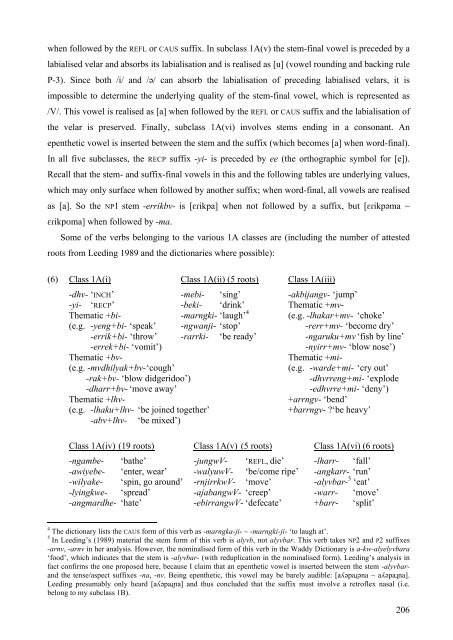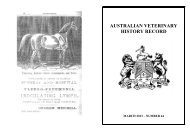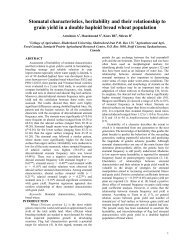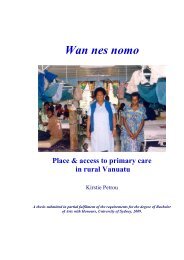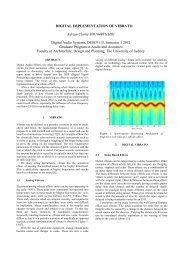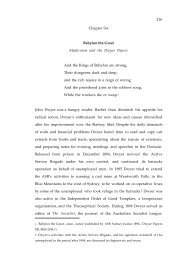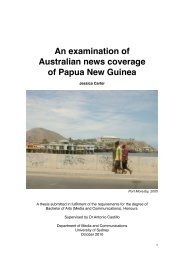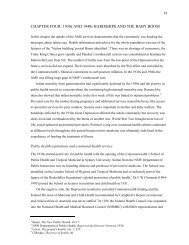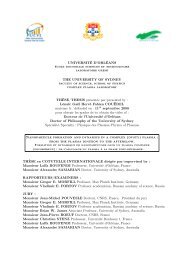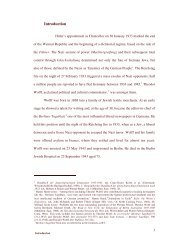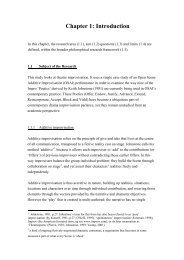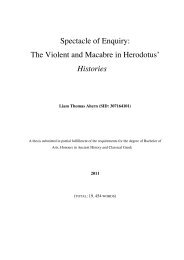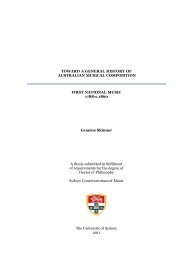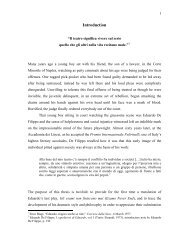Chapter 6: Tense, aspect and mood
Chapter 6: Tense, aspect and mood
Chapter 6: Tense, aspect and mood
You also want an ePaper? Increase the reach of your titles
YUMPU automatically turns print PDFs into web optimized ePapers that Google loves.
when followed by the REFL or CAUS suffix. In subclass 1A(v) the stem-final vowel is preceded by a<br />
labialised velar <strong>and</strong> absorbs its labialisation <strong>and</strong> is realised as [u] (vowel rounding <strong>and</strong> backing rule<br />
P-3). Since both /i/ <strong>and</strong> /əә/ can absorb the labialisation of preceding labialised velars, it is<br />
impossible to determine the underlying quality of the stem-final vowel, which is represented as<br />
/V/. This vowel is realised as [a] when followed by the REFL or CAUS suffix <strong>and</strong> the labialisation of<br />
the velar is preserved. Finally, subclass 1A(vi) involves stems ending in a consonant. An<br />
epenthetic vowel is inserted between the stem <strong>and</strong> the suffix (which becomes [a] when word-final).<br />
In all five subclasses, the RECP suffix -yi- is preceded by ee (the orthographic symbol for [e]).<br />
Recall that the stem- <strong>and</strong> suffix-final vowels in this <strong>and</strong> the following tables are underlying values,<br />
which may only surface when followed by another suffix; when word-final, all vowels are realised<br />
as [a]. So the NP1 stem -errikbv- is [ɛɾikpa] when not followed by a suffix, but [ɛɾikpəәma ~<br />
ɛɾikpʊma] when followed by -ma.<br />
Some of the verbs belonging to the various 1A classes are (including the number of attested<br />
roots from Leeding 1989 <strong>and</strong> the dictionaries where possible):<br />
(6) Class 1A(i) Class 1A(ii) (5 roots) Class 1A(iii)<br />
-dhv- ‘INCH’ -mebi- ‘sing’ -akbijangv- ‘jump’<br />
-yi- ‘RECP’ -beki- ‘drink’ Thematic +mv-<br />
Thematic +bi- -marngki- ‘laugh’ 4 (e.g. -lhakar+mv- ‘choke’<br />
(e.g. -yeng+bi- ‘speak’ -ngwanji- ‘stop’ -rerr+mv- ‘become dry’<br />
-errik+bi- ‘throw’ -rarrki- ‘be ready’ -ngaruku+mv ‘fish by line’<br />
-errek+bi- ‘vomit’) -nyirr+mv- ‘blow nose’)<br />
Thematic +bv- Thematic +mi-<br />
(e.g. -mvdhilyak+bv- ‘cough’ (e.g. -warde+mi- ‘cry out’<br />
-rak+bv- ‘blow didgeridoo’) -dhvrreng+mi- ‘explode<br />
-dharr+bv- ‘move away’ -edhvrre+mi- ‘deny’)<br />
Thematic +lhv- +arrngv- ‘bend’<br />
(e.g. -lhaku+lhv- ‘be joined together’ +barrngv- ?‘be heavy’<br />
-abv+lhv- ‘be mixed’)<br />
Class 1A(iv) (19 roots) Class 1A(v) (5 roots) Class 1A(vi) (6 roots)<br />
-ngambe- ‘bathe’ -jungwV- ‘REFL, die’ -lharr- ‘fall’<br />
-awiyebe- ‘enter, wear’ -walyuwV- ‘be/come ripe’ -angkarr- ‘run’<br />
-wilyake- ‘spin, go around’ -rnjirrkwV- ‘move’ -alyvbar- 5 ‘eat’<br />
-lyingkwe- ‘spread’ -ajabangwV- ‘creep’ -warr- ‘move’<br />
-angmardhe- ‘hate’ -ebirrangwV- ‘defecate’ +barr- ‘split’<br />
4 The dictionary lists the CAUS form of this verb as -marngka-ji- ~ -marngki-ji- ‘to laugh at’.<br />
5 In Leeding’s (1989) material the stem form of this verb is alyvb, not alyvbar. This verb takes NP2 <strong>and</strong> P2 suffixes<br />
-arnv, -arnv in her analysis. However, the nominalised form of this verb in the Waddy Dictionary is a-kw-alyelyvbara<br />
‘food’, which indicates that the stem is -alyvbar- (with reduplication in the nominalised form). Leeding’s analysis in<br />
fact confirms the one proposed here, because I claim that an epenthetic vowel is inserted between the stem -alyvbar-<br />
<strong>and</strong> the tense/<strong>aspect</strong> suffixes -na, -nv. Being epenthetic, this vowel may be barely audible: [aʎəәpaɻəәna ~ aʎəәpaɻna].<br />
Leeding presumably only heard [aʎəәpaɻna] <strong>and</strong> thus concluded that the suffix must involve a retroflex nasal (i.e.<br />
belong to my subclass 1B).<br />
206


